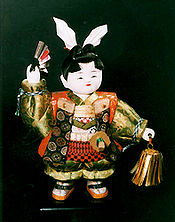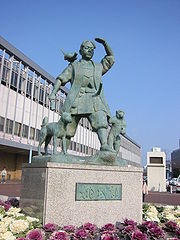
Momotaro
Encyclopedia

Hero
A hero , in Greek mythology and folklore, was originally a demigod, their cult being one of the most distinctive features of ancient Greek religion...
from Japanese folklore
Japanese folklore
The folklore of Japan is heavily influenced by both Shinto and Buddhism, the two primary religions in the country. It often involves humorous or bizarre characters and situations and also includes an assortment of supernatural beings, such as bodhisattva, kami , yōkai , yūrei ,...
. His name literally means Peach Tarō; as Tarō
Taro (given name)
Tarō is a stand-alone Japanese given name or a common name suffix for males .People named Tarō include:*Akebono Tarō , retired sumo wrestler from Hawaii*Asashio Tarō IV , retired sumo wrestler...
is a common Japanese boy's name, it is often translated as Peach Boy. Momotarō is also the title of various books, films, and other works that portray the tale of this hero.
Story
According to the present form of the tale (dating to the Edo periodEdo period
The , or , is a division of Japanese history which was ruled by the shoguns of the Tokugawa family, running from 1603 to 1868. The political entity of this period was the Tokugawa shogunate....
), Momotarō came to Earth inside a giant peach
Peach
The peach tree is a deciduous tree growing to tall and 6 in. in diameter, belonging to the subfamily Prunoideae of the family Rosaceae. It bears an edible juicy fruit called a peach...
, which was found floating down a river by an old, childless woman who was washing clothes there. The woman and her husband discovered the child when they tried to open the peach to eat it. The child explained that he had been sent by Heaven
Heaven
Heaven, the Heavens or Seven Heavens, is a common religious cosmological or metaphysical term for the physical or transcendent place from which heavenly beings originate, are enthroned or inhabit...
to be their son. The couple named him Momotarō, from momo (peach) and tarō (eldest son in the family).
Years later, Momotarō left his parents to fight a band of marauding oni (demons or ogre
Ogre
An ogre is a large, cruel, monstrous, and hideous humanoid monster, featured in mythology, folklore, and fiction. Ogres are often depicted in fairy tales and folklore as feeding on human beings, and have appeared in many classic works of literature...
s) on a distant island
Island
An island or isle is any piece of sub-continental land that is surrounded by water. Very small islands such as emergent land features on atolls can be called islets, cays or keys. An island in a river or lake may be called an eyot , or holm...
. En route, Momotarō met and befriended a talking dog
Dog
The domestic dog is a domesticated form of the gray wolf, a member of the Canidae family of the order Carnivora. The term is used for both feral and pet varieties. The dog may have been the first animal to be domesticated, and has been the most widely kept working, hunting, and companion animal in...
, monkey
Monkey
A monkey is a primate, either an Old World monkey or a New World monkey. There are about 260 known living species of monkey. Many are arboreal, although there are species that live primarily on the ground, such as baboons. Monkeys are generally considered to be intelligent. Unlike apes, monkeys...
, and pheasant
Pheasant
Pheasants refer to some members of the Phasianinae subfamily of Phasianidae in the order Galliformes.Pheasants are characterised by strong sexual dimorphism, males being highly ornate with bright colours and adornments such as wattles and long tails. Males are usually larger than females and have...
, who agreed to help him in his quest. At the island, Momotarō and his animal friends penetrated the demons' fort and beat the band of demons into surrendering. Momotarō and his new friends returned home with the demons' plundered treasure and the demon chief as a captive. Momotarō and his family lived comfortably from then on.
Momotarō is strongly associated with Okayama, and his tale may have its origins there. The demon island of the story is sometimes associated with Megijima
Megijima
is an island located in the Inland Sea of Japan, north of the city of Takamatsu, and is part of Kagawa Prefecture. It has an area of 2.66 km2, a coastline of 8.9 km, and a population of about 200....
Island, an island in the Seto Inland Sea near Takamatsu
Takamatsu, Kagawa
is a city located in central Kagawa Prefecture on the island of Shikoku in Japan, and is the seat of the prefectural government. It is designated a core city by the Japanese Government. It is a port city located on the Seto Inland Sea, and is the closest port to Honshu from Shikoku island...
, due to the vast manmade cave
Cave
A cave or cavern is a natural underground space large enough for a human to enter. The term applies to natural cavities some part of which is in total darkness. The word cave also includes smaller spaces like rock shelters, sea caves, and grottos.Speleology is the science of exploration and study...
s found on that island.
Variants
There are a few variants to the story, depending on geographical region. Some say Momotaro floated by in a box, a white peach, or a red peach. Stories from ShikokuShikoku
is the smallest and least populous of the four main islands of Japan, located south of Honshū and east of the island of Kyūshū. Its ancient names include Iyo-no-futana-shima , Iyo-shima , and Futana-shima...
and Chugoku region muddy the distinction with characters from another folk story, the Monkey-Crab Battle
The Crab and the Monkey
The Crab and the Monkey, also known as or The Quarrel of the Monkey and the Crab, is a Japanese folktale. In the story, a sly monkey kills a crab, and is later killed in revenge by the crab's offspring. Retributive justice is the main theme of the story.The Crab and the Monkey is included in the...
that Momotaro took with him allies to Oni Island, namely a , a , a , a , and a . In old days, all these animals and objects were believed to possess spirits and could move by their own will. The cowpie was sometimes given the honorific dono (殿). This was to appease the cowpie spirit, so as it won't move to be under you when you stumble or take a step.
Momotaro Festival
Inuyama, Japan holds a festival every years called the Momotaro Festival held at the Momotaro Shrine on May 5 every year.Momotarō's song

Children's song
Children's song may be a nursery rhyme set to music, a song that young children invent and share among themselves, or a modern creation intended for entertainment, use in the home, or education...
about Momotarō titled Momotarō-san no Uta (Momotarō's Song) was first published in 1911. One version of it is included below with romanization and translation.
« Momotarō-san no uta »
桃太郎さんの歌
Momotarō-san, Momotarō-san
(Momotarō, Momotarō)
桃太郎さん、桃太郎さん
Okoshi ni tsuketa kibidango
(Those millet
Proso millet
Proso millet is also known as common millet, hog millet or white millet. Both the wild ancestor and the location of domestication of proso millet are unknown, but it first appears as a crop in both Transcaucasia and China about 7,000 years ago, suggesting that it may have been domesticated...
dumplings on your waist)
お腰につけたきびだんご
Hitotsu watashi ni kudasai na?
(Won't you give me one?)
一つ私に下さいな!
Agemashō, agemashō
(I'll give you one, I'll give you one)
あげましょう、あげましょう
Kore kara oni no seibatsu ni
(From now, on a quest to conquer the ogres)
これから鬼の征伐に
Tsuite kuru nara agemashō
(If you come with me, I'll give one to you)
ついてくるならあげましょう

